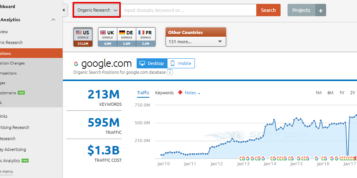Google views backlinks (links to your website from other sites) as a ‘vote of confidence’ in the quality of your site. And most marketers who have any knowledge of SEO will know that backlinks have always been one of the most critical factors in ensuring your site ranks well in searches. However in the light of Google’s search algorithm revisions, including this year’s Penguin update, there has been a shift in the relationship between these links and SEO.
The number of backlinks to a site is still very important for rankings. And websites that rank highly contain an even higher number of backlinks than in 2012.
These findings come from Searchmetrics’ 2013 study of Google Ranking Factors and Rank Correlations. But the research, which analysed 10,000 popular keywords and 300,000 websites to identify the factors that correlate with ranking well on Google, found that the search giant is now placing even more emphasis on the quality of backlinks, rewarding ‘natural’ link profiles and high quality links. So the role played by backlinks and SEO is evolving.
Here are four findings in this area that marketers should understand:
1. Keep backlink numbers high
Firstly, it’s important to emphasise that backlink numbers have always been essential to achieving good Google visibility – and still remain immensely important. Sites ranking in the top position on Google have an average of 6,038 backlinks, dropping to 2,221 for those placing second – and plummeting to around 70 for those ranked 30th.
Although it is possible to rank highly with just a few links in very specific cases, generally it is still vital to encourage as many backlinks as you can within your site. However as we will see in coming points, Google is getting better at spotting sites that are artificially generating links just to improve rankings, so the structure and composition of links have to be ‘natural’.
2. Keywords in the anchor text are becoming less relevant
Having a comparatively large number of hard keyword anchor text placed within links (i.e. links which contain exact matches for popular keywords or search terms), is a factor that Google appears to be increasingly suspicious about. The positive correlation for hard keyword anchor text has decreased significantly and is expected to decrease further. This doesn’t mean that anchor text shouldn’t contain keywords; just that it should be part of a more diverse range of backlinks so that it appears more natural.
After all, if a large number of webmasters independently link to a website with exactly the same anchor text, it looks at the very least unusual – and raises concerns that the links are being artificially manipulated. In fact on average it was found that 37 per cent of backlinks to websites ranked in the top 30 positions contained keywords in the anchor text.
3. Link diversity is all important
So if too many backlinks with the same popular keywords or anchor text looks unnatural to Google, then what would look more natural? The study indicates that it is important to have a certain proportion of links with stop words (“and”, “to” etc.) or generic terms (“here”, “this” etc.) ‒ the URLs in the first four positions in the search results were found to have a higher proportion of links with these stop words than websites that rank below them.
Moreover our analysis indicates that Google is looking for a diverse link profile, including a proportion of “nofollow” links (those links that do not convey a direct benefit to rankings) and links which use the specific brand name (if there is one) of the site the link directs to, as well as links with multiple words in them.
4. Quality will come out on top
The study supports the view that backlinks from high quality, high ranking sites that generate a lot of traffic themselves will increase your own ranking. This means that a backlink from a top website such as bbc.co.uk will have a greater positive impact than a link from a relatively unknown blog. At Searchmetrics we use a metric called the SEO Visibility¹ score as a way of estimating a sites’ ‘quality’, how highly it ranks for popular keywords and its traffic generating potential. We found that backlinks from websites with high SEO Visibility seem to be much more valuable than links from websites with low SEO Visibility.
In fact we found that websites ranked in first place in our study have links from sites with an average SEO visibility of over 8,636 while those in the 30th place include backlinks from sites that average just 664. The lesson here is to ensure that you are focusing your backlink strategy on those sites that have quality content, high visibility and a lot of traffic. Nevertheless, bear in mind that including a certain amount of lower quality links is also part of a natural link profile.
As our SEO Ranking Factors – Rank Correlation 2013 for Google Study has demonstrated, backlinks continue to be one of the most critical SEO metrics, but how you succeed in this area has changed. So the lesson for marketers is simple – be natural and focus on quality as well as quantity links if you want to move up the search rankings.
¹SEO Visibility
Searchmetrics tracks the paid and organic ranking of millions of keywords every week. It calculated the ‘SEO Visibility’ score for web sites based on:
- The number of times a domain appears in the search engine results pages (SERPs) across the keyword set
- Its prominence within those SERPs (a higher ranking equates to a higher visibility score)
The competitiveness of the keyword (higher search volumes equate to a higher visibility score)





